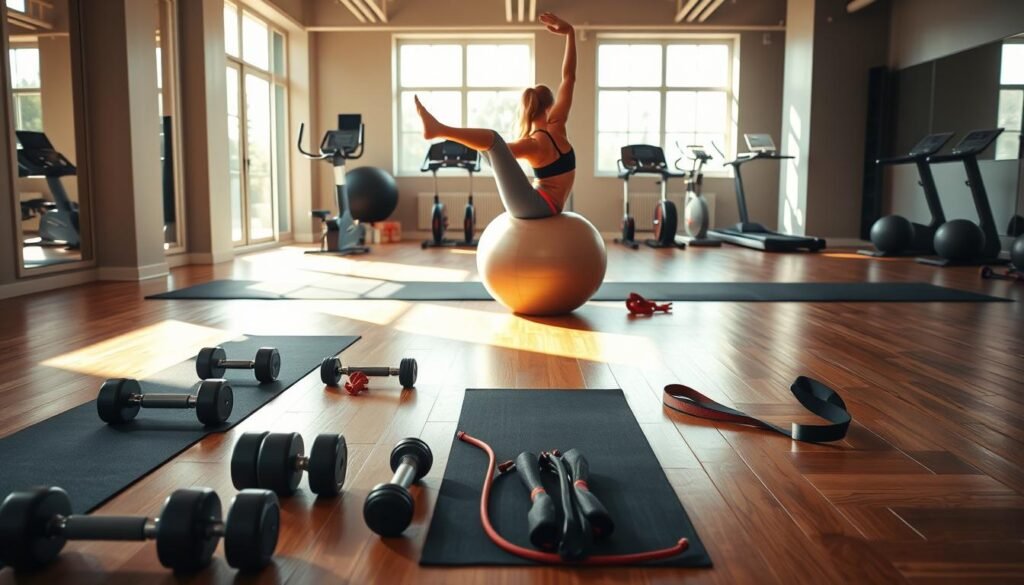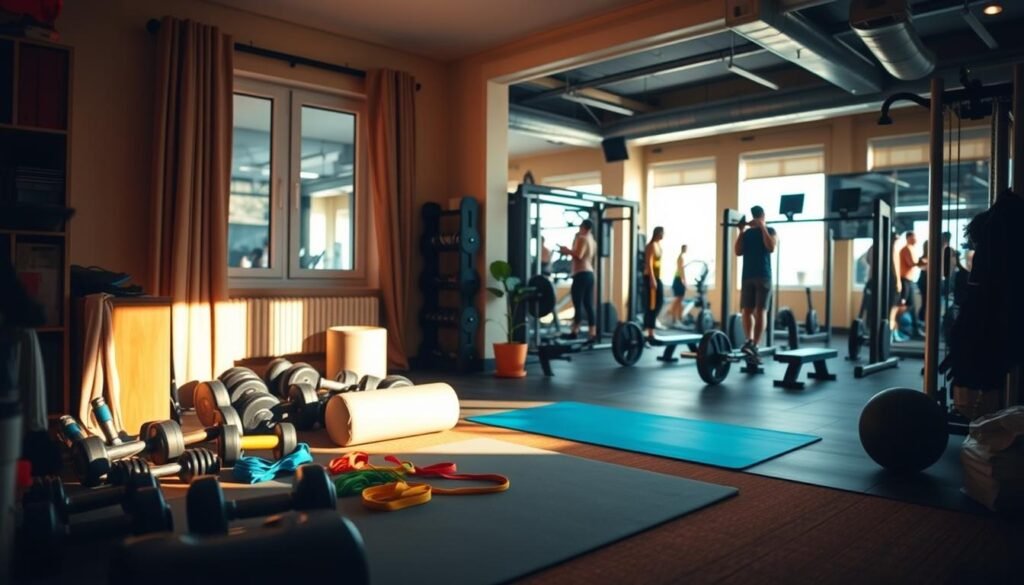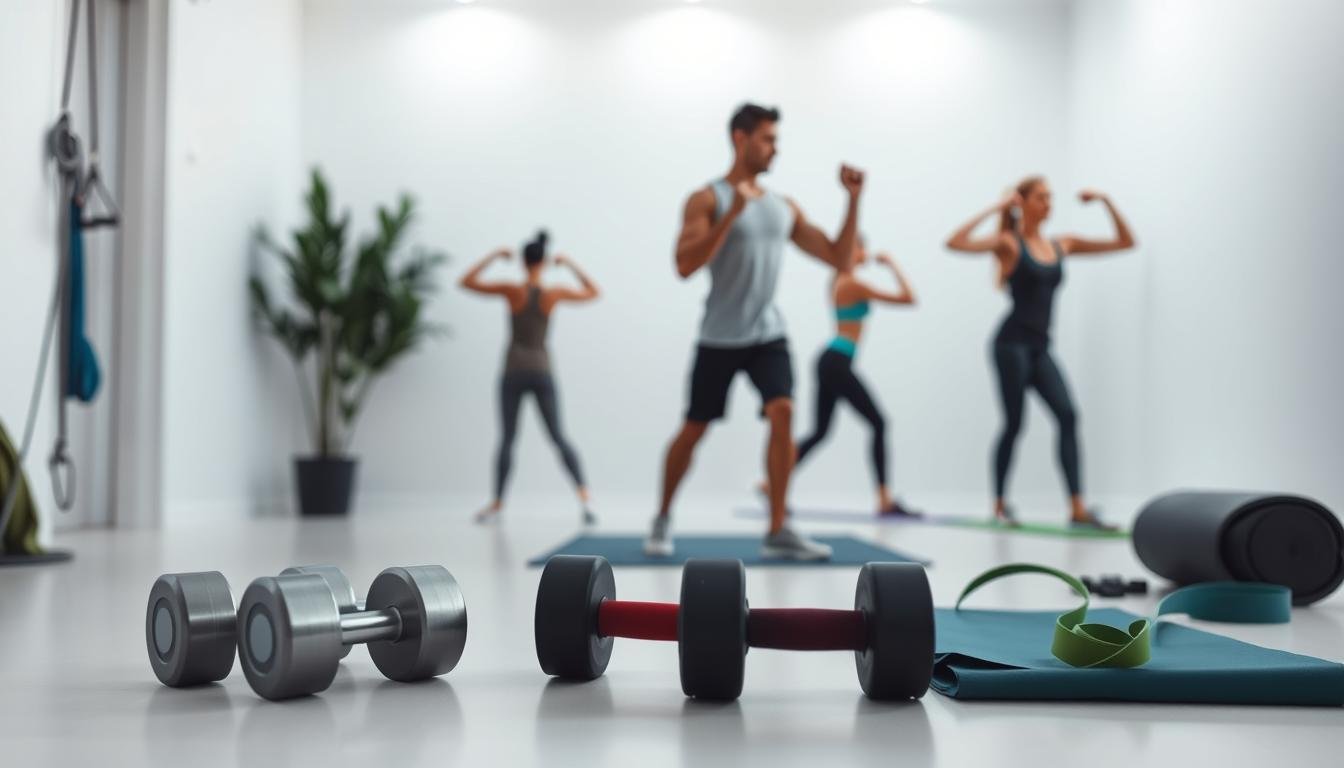Did you know nearly 75% of people who start a fitness program drop out within a year? The Mayo Clinic emphasizes the importance of setting clear goals and measuring fitness levels for a successful plan. A well-structured workout plan can significantly enhance one’s ability to achieve their fitness objectives.
Having effective exercise routines is vital to reaching your fitness goals. Regular physical activity not only improves overall health but also boosts mental well-being. A personalized approach to fitness ensures that individuals can maintain their motivation and track progress.
Key Takeaways
- Setting clear fitness goals is essential for success.
- A well-structured workout plan enhances fitness outcomes.
- Regular exercise improves overall health and mental well-being.
- A personalized fitness approach boosts motivation.
- Tracking progress is key to achieving fitness objectives.
Understanding Your Fitness Goals
Starting your fitness journey requires a clear understanding of your objectives. Setting specific goals helps you measure your progress and stay motivated, as the Mayo Clinic advises.
Defining Clear and Realistic Objectives
It’s vital to set clear and realistic fitness goals. You need to identify what you aim to achieve, whether it’s losing weight, building muscle, or boosting endurance.
The Importance of Measurable Targets
Having measurable targets is key to tracking your progress. For example, setting a goal to run a certain distance or lift a specific weight provides clear milestones.
Short-term vs. Long-term Fitness Goals
Knowing the difference between short-term and long-term goals is essential. Short-term goals offer immediate motivation. Long-term goals, on the other hand, provide direction and purpose.
Assessing Your Current Fitness Level
Evaluating your fitness level is the first step towards achieving your fitness goals. It involves understanding your aerobic capacity, muscular strength, flexibility, and body composition. This assessment helps in creating a tailored workout plan that addresses your specific needs.
Self-Assessment Techniques
Self-assessment is a convenient way to gauge your fitness level. You can start by:
- Measuring your heart rate and blood pressure
- Assessing your flexibility through simple exercises like touching your toes
- Evaluating your muscular endurance by performing push-ups or squats
These techniques provide a baseline understanding of your current fitness status.
Professional Fitness Evaluations
For a more accurate assessment, consider consulting a fitness professional. They can conduct a range of evaluations, including:
- VO2 Max Testing to measure aerobic capacity
- Strength and Endurance Tests to assess muscular fitness
- Body Composition Analysis to determine body fat percentage
A professional evaluation provides detailed insights into your fitness level, helping you set realistic goals.
Tracking Your Starting Point
Once you’ve assessed your fitness level, it’s essential to track your starting point. This involves:
- Recording your initial measurements and performance metrics
- Setting specific, measurable goals
- Regularly monitoring your progress
Tracking your progress not only motivates you but also helps in adjusting your workout plan as needed.
The Science Behind Effective Exercise Routines
Effective exercise routines are based on a deep understanding of human physiology and how it responds to exercise. To achieve desired fitness outcomes, it’s essential to grasp the scientific principles that govern our body’s adaptation to physical stress.
Understanding Exercise Physiology
Exercise physiology studies how the body reacts to and adapts to physical activity. It looks at various physiological systems, like the cardiovascular, muscular, and nervous systems, and how they interact during exercise. Understanding exercise physiology is key to designing effective exercise routines.
Progressive Overload Principle
A fundamental principle in exercise science is progressive overload. It involves gradually increasing workout intensity to challenge muscles and stimulate growth and strength. Progressive overload is vital for building muscle and strength over time. Gainful notes that progressive overload is a critical part of effective resistance training programs.
- Increasing weight or resistance
- Enhancing the frequency or duration of workouts
- Improving the intensity of exercise through various techniques
Recovery and Adaptation
Recovery and adaptation are equally vital in exercise science. After a workout, the body needs time to recover and adapt to the stress it has undergone. Adequate recovery allows muscles to repair and grow, leading to increased strength and endurance. It’s important to balance exercise with recovery to avoid overtraining and prevent injury.
- Allowing rest days as part of the workout routine
- Ensuring proper nutrition to support recovery
- Getting sufficient sleep to aid in adaptation
By understanding and applying these scientific principles, individuals can create effective exercise routines tailored to their specific fitness goals.
Essential Components of Balanced Workout Plans
To achieve optimal fitness, it’s vital to incorporate a mix of different exercise types into your routine. A balanced workout plan is designed to improve overall health and fitness by addressing various aspects of physical performance.
Cardiovascular Training Elements
Cardiovascular exercises, such as running, cycling, or swimming, are key for heart health and endurance. These activities burn calories and boost the body’s oxygen and nutrient transport.
Strength and Resistance Work
Strength training uses resistance to build muscle and enhance strength. It can be done through weightlifting, bodyweight exercises, or resistance bands. This strengthens muscles, improves bone density, and boosts metabolic health.
Flexibility and Mobility
Flexibility exercises, like stretching and yoga, enhance range of motion and lower injury risk. Mobility training focuses on full joint motion, improving flexibility and functional movement.
Balance and Stability Training
Balance and stability exercises improve proprioception and stability. Examples include single-leg squats, balance boards, and certain yoga poses.
| Component | Examples | Benefits |
|---|---|---|
| Cardiovascular Training | Running, Cycling, Swimming | Improved heart health, increased endurance |
| Strength and Resistance Work | Weightlifting, Bodyweight exercises, Resistance bands | Muscle mass, improved strength, bone density |
| Flexibility and Mobility | Stretching, Yoga | Improved range of motion, reduced injury risk |
| Balance and Stability Training | Single-leg squats, Balance boards, Yoga poses | Improved proprioception, stability |

Creating Personalized Exercise Routines for Different Goals
Different fitness goals demand unique exercise strategies, making personalized routines vital. Whether your aim is weight loss, muscle building, endurance, or functional fitness, a customized workout plan is key. It helps you reach your goals more effectively.
Routines for Weight Loss
For weight loss, a mix of cardio and strength training is advised. High-intensity interval training (HIIT) boosts calorie burn and metabolic health. A sample routine could include 30 minutes of HIIT cardio, three times a week, alongside strength training for all major muscle groups.
Programs for Muscle Building
To build muscle, focus on resistance training that pushes your muscles. Compound movements like squats, deadlifts, and bench presses are effective. Train each major muscle group at least twice a week, ensuring progressive overload to stimulate growth.
Endurance-Focused Regimens
For endurance, consistent cardio training is essential. Activities like running, cycling, or swimming at moderate intensity for long periods boost cardiovascular health and stamina. Long slow distance (LSD) training also adds benefits.
Functional Fitness Approaches
Functional fitness enhances your ability to perform daily tasks and movements. It includes bodyweight exercises, resistance band training, and activities that improve coordination and balance. A functional fitness routine might involve circuit training with exercises like squats, lunges, and planks.
Understanding your fitness goals and crafting a personalized workout plan optimizes your exercise routine for success.
Step-by-Step Guide to Building Strength
Building strength effectively requires a mix of compound movements and progressive resistance. Understanding these concepts and applying them in a workout routine is key. This approach leads to significant strength gains.
Selecting Compound Movements
Compound movements engage multiple muscle groups at once. Examples include squats, deadlifts, and bench presses. These exercises are essential for building muscle mass and strength efficiently.
- Squats: Works the legs, glutes, and lower back.
- Deadlifts: Engages the entire back, legs, and core.
- Bench Press: Targets the chest, shoulders, and triceps.
Implementing Progressive Resistance
Progressive resistance means increasing the weight or resistance in exercises over time. This challenges muscles and promotes strength gains. Ways to do this include:
- Increasing the weight lifted.
- Adding more repetitions or sets.
- Decreasing rest time between sets.
Sample Weekly Strength Program
Strength programs vary based on experience level. Below are examples for beginners and intermediates.
Beginner Strength Routine
| Day | Exercise | Sets x Reps |
|---|---|---|
| Monday | Squats | 3 x 8 |
| Monday | Bench Press | 3 x 8 |
| Wednesday | Deadlifts | 3 x 8 |
| Friday | Rows | 3 x 8 |
Intermediate Strength Plan
| Day | Exercise | Sets x Reps |
|---|---|---|
| Monday | Front Squats | 4 x 6 |
| Monday | Incline Bench Press | 4 x 6 |
| Wednesday | Sumo Deadlifts | 4 x 6 |
| Friday | Pull-ups | 4 x Max |
Fitness expert Gainful notes, “Compound movements and progressive resistance are key to building strength.” By incorporating these into a workout routine, individuals can see significant strength gains over time.

Cardio Exercise Routines for Improved Endurance
Boosting your endurance through cardio exercises enhances your heart health and fitness level. Regular cardio workouts increase stamina, improve heart function, and uplift mental well-being.
Designing Steady-State Cardio Sessions
Steady-state cardio requires maintaining a moderate exercise intensity for a long time. It’s great for boosting cardiovascular health and endurance.
- Duration: Aim for at least 30 minutes per session.
- Intensity: Moderate intensity, where you can hold a conversation.
- Examples: Jogging, cycling, swimming, or gym cardio machines.
Creating Effective HIIT Workouts
High-Intensity Interval Training (HIIT) combines short, intense exercise bursts with brief rest periods. It’s excellent for cardiovascular health and metabolism boost.
- Warm-up: 5 minutes of light cardio.
- Intervals: 30 seconds of intense exercise, then 30 seconds rest.
- Repeat: For 15-20 minutes.
- Cool-down: 5 minutes of stretching.
Cross-Training Methods for Cardiovascular Health
Cross-training mixes different cardio exercises to prevent boredom and injury risks. It enhances overall cardiovascular fitness.
- Mix and Match: Combine running, cycling, swimming, or rowing in your weekly routine.
- Group Classes: Join group fitness classes with varied cardio exercises.
- Outdoor Activities: Add outdoor activities like hiking or kayaking.
Incorporating these cardio routines into your fitness plan can greatly enhance endurance and cardiovascular health.
Home vs. Gym Exercise Plans: Maximizing Your Environment
Choosing the right workout environment is key to reaching your fitness goals, whether at home or in the gym. Both settings offer unique benefits and can be customized to meet individual needs.
Equipment-Free Home Workout Routines
Bodyweight exercises are highly effective for home workouts. Push-ups, squats, and lunges engage multiple muscle groups and require no equipment. Bodyweight exercises are versatile and can be adjusted to fit different fitness levels.
Minimal Equipment Home Training
For those seeking more resistance, minimal equipment like resistance bands or a pull-up bar can enhance home workouts. Resistance bands are lightweight, inexpensive, and portable, making them perfect for home training.
Optimizing Gym Exercise Plans
Gyms provide a wide range of equipment and machines for targeting specific muscle groups. A well-structured gym plan includes cardio, strength training, and flexibility exercises. Using a gym’s resources keeps workouts varied and engaging.
Creating a Consistent Training Program in Any Setting
Consistency is essential for achieving fitness goals. Whether at home or in the gym, establishing a routine and adhering to it is vital. Setting clear, achievable goals and tracking progress helps maintain motivation.
| Workout Aspect | Home Workout | Gym Workout |
|---|---|---|
| Equipment | Minimal to none | Variety of machines and free weights |
| Cost | Low to no cost | Membership fees apply |
| Environment | Private, comfortable | Public, motivating |

The decision between home and gym workouts hinges on personal preference, fitness goals, and lifestyle. Understanding the benefits of each allows individuals to craft a workout plan that maximizes their environment and supports their fitness objectives.
Implementing a Daily Exercise Schedule That Works
Creating a daily exercise schedule that fits your lifestyle is key to reaching your fitness goals. The Mayo Clinic stresses the importance of balancing exercise with recovery to avoid burnout and injury. This balance allows your body to repair and strengthen muscles, making your workouts more effective over time.
Morning vs. Evening Workouts
The choice between morning and evening workouts depends on personal preference and schedule. Morning workouts can increase your energy and set a positive tone for the day. In contrast, evening workouts can help relieve stress after a long day. Finding the best time for you involves experimenting with different schedules.
Splitting Routines Across the Week
Spreading out your workouts throughout the week allows for varied activities and enough rest. For example, you might do strength training on Monday, Wednesday, and Friday. Then, dedicate Tuesday and Thursday to cardio. This method ensures a balanced fitness routine.
Balancing Exercise with Recovery
Fitness experts highlight the importance of recovery alongside exercise. It’s essential to include rest days or active recovery days, like yoga or light walking.
“Rest is not idleness, and to lie sometimes on the grass under trees on a summer’s day, listening to the murmur of the water, or watching the clouds float across the sky, is by no means a waste of time.”
This balance is critical to prevent overtraining and reduce injury risk.
Adapting to Life’s Demands
Life’s unpredictability means your exercise schedule must be flexible. Whether it’s a sudden work commitment or family obligations, having a backup plan, like home workouts, is vital. This flexibility helps you stay committed to your fitness goals.
Nutrition and Hydration to Support Your Fitness Regimens
To enhance your workout performance and recovery, focus on your nutrition and hydration strategies. Proper nutrition fuels your body for optimal exercise performance. Hydration ensures your body functions at its best.
Pre and Post-Workout Nutrition Strategies
Choosing the right nutrients before and after workouts significantly impacts your performance and recovery. Pre-workout nutrition should energize and support muscle function. Post-workout nutrition focuses on recovery and muscle repair.
A balanced meal or snack with carbohydrates and protein is advised before and after exercise. For example, a banana with peanut butter before a workout offers sustained energy. A protein shake with carbohydrates after a workout aids in muscle recovery.
Hydration Protocols for Different Exercise Types
Hydration is essential for all exercises, but needs vary by intensity and duration. For endurance activities like long-distance running, staying hydrated is critical throughout.
Drink water before, during, and after exercise as a general guideline. For intense or long workouts, consider a sports drink with electrolytes to replace lost salts.
Meal Timing Around Your Workout Routine
The timing of meals relative to workouts affects performance and recovery. Eating too close to a workout can cause discomfort. Eating too late after can delay recovery.
Eat a balanced meal 1-3 hours before your workout. Refuel within 30-60 minutes after to optimize performance and recovery.
Tracking Progress and Adjusting Your Exercise Routines
To keep improving, tracking your progress and adjusting your workouts is key. Regular monitoring helps pinpoint your strengths and weaknesses. This knowledge guides your fitness plan.
Effective Metrics to Monitor
Choosing the right metrics is essential for gauging your progress. Important metrics include:
- Workout performance (e.g., weight lifted, distance run)
- Body composition changes (e.g., weight, body fat percentage)
- Cardiovascular endurance improvements
When and How to Modify Your Workouts
Adjusting your workouts based on your progress is critical. If you’re not seeing gains, it’s time to up the intensity or switch things up.
Tips for modification:
- Increase weight or resistance
- Change your exercise routine to avoid plateaus
- Adjust your cardio regimen for improved endurance
Overcoming Plateaus with Program Variations
Plateaus are a natural part of fitness. Shaking up your routine can help break through them.
Strategies include:
- Changing your workout split
- Incorporating new exercises
- Adjusting your nutrition plan
Using Technology to Track Performance
Technology is a powerful ally in tracking fitness progress. Fitness apps, wearable devices, and online platforms offer deep insights into your performance.
Conclusion
As we wrap up our look at effective exercise routines, it’s evident that hitting your fitness goals demands a well-rounded approach. We’ve covered the need to know your fitness aims, evaluate your current fitness state, and craft tailored workout plans.
By mixing cardiovascular training, strength and resistance work, and flexibility exercises, you can build a balanced workout plan. It’s key to monitor your progress and tweak your routines when necessary. This helps you avoid plateaus and reach lasting success.
With the tools and knowledge to build an effective exercise routine, it’s time to start or keep up your fitness journey. Stay dedicated, be patient, and celebrate every step of your progress.
Sources
For further information on effective exercise routines and fitness goals, the following sources were consulted:
Mayo Clinic provides detailed guides on exercise and fitness. They offer tips on creating a workout routine and understanding exercise physiology.
Gainful also offers personalized nutrition and fitness plans. They highlight the importance of tailored approaches to achieving fitness objectives.
Other reputable health and fitness websites, such as the American College of Sports Medicine, provide evidence-based information. They focus on exercise science and fitness training.
These sources serve as valuable references for individuals seeking to enhance their understanding of effective exercise routines. They aim to help achieve fitness goals.
FAQ
What makes an exercise routine effective?
An effective exercise routine is tailored to an individual’s fitness goals. It includes a mix of cardiovascular, strength, and flexibility training. It also incorporates progressive overload to challenge the body and promote adaptation.
How do I determine my fitness goals?
To determine your fitness goals, start by assessing your current fitness level. Then, identify what you want to achieve, whether it’s weight loss, muscle building, or improved endurance. Make sure your goals are clear, measurable, and aligned with your values.
What is the importance of progressive overload in a workout routine?
Progressive overload is essential in a workout routine. It challenges the muscles and promotes adaptation. This leads to increased strength, endurance, and overall fitness.
How often should I work out to achieve my fitness goals?
The frequency of workouts depends on individual goals and current fitness level. A consistent training program with a balance of exercise and recovery is key to achieving fitness objectives.
Can I create an effective workout routine at home?
Yes, you can create an effective workout routine at home. Use bodyweight exercises, resistance bands, or other home training methods. Tailor the routine to your specific fitness goals.
How do I track my progress and adjust my workout routine?
To track progress, use metrics like weight, body fat percentage, or workout performance. Adjust your routine by modifying exercises, increasing intensity or volume, or changing your training program to overcome plateaus.
What role does nutrition play in fitness?
Nutrition plays a critical role in fitness. It provides the body with the necessary fuel to support workouts, aid in recovery, and promote overall health. Nutrition should be tailored to individual fitness goals and needs.
How do I balance exercise with recovery?
Balancing exercise with recovery involves allowing time for rest and relaxation. Incorporate stretching and foam rolling. Adjust the intensity and volume of workouts to avoid burnout and prevent injury.
What are the benefits of HIIT workouts?
HIIT workouts offer numerous benefits. They improve cardiovascular endurance, increase caloric burn, and enhance metabolic function. They are an effective and efficient way to improve overall fitness.
How can I stay motivated to continue my fitness journey?
Staying motivated involves setting realistic goals and tracking progress. Find a workout community or accountability partner. Vary your routine to avoid boredom and prevent plateaus.
